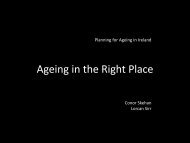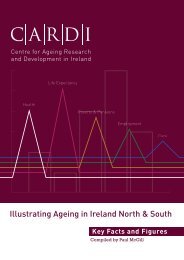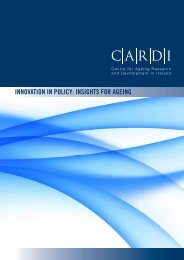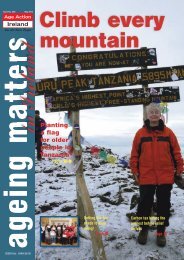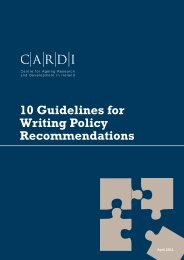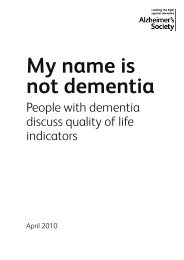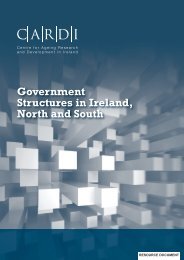Create successful ePaper yourself
Turn your PDF publications into a flip-book with our unique Google optimized e-Paper software.
Research Brief<br />
<strong>Transport</strong> &<br />
<strong>Rural</strong> <strong>Ageing</strong>
NI <strong>Transport</strong> policy<br />
NI <strong>Transport</strong> policy<br />
Several policy initiatives in NI have<br />
the aim of improving transport for<br />
older people:<br />
• The Programme for Government<br />
2008-2011: Building a Better<br />
Future explicitly recognises the<br />
importance of transport<br />
infrastructure in relation to<br />
economic growth and social<br />
inclusion across the region.<br />
• The Accessible <strong>Transport</strong> Strategy<br />
for Northern Ireland 2015 (ATS)<br />
was published in March 2005<br />
and its vision is an accessible<br />
transport system that enables<br />
older people and disabled people<br />
to participate more fully in society,<br />
enjoy greater independence and<br />
experience a better quality of life.<br />
• The Regional <strong>Transport</strong> Strategy<br />
(RTS) for Northern Ireland 2002-<br />
2012 sits within the framework of<br />
the Regional Development Strategy:<br />
Shaping our Future. The RTS<br />
recognises that transport is<br />
essential to provide access to<br />
employment and training<br />
opportunities, to services such<br />
as health and social services, to<br />
shops and education. Its vision is to<br />
have a modern, sustainable, safe<br />
transportation system which benefits<br />
society, the economy and the<br />
environment and which actively<br />
contributes to social inclusion and<br />
everyone’s quality of life.<br />
ROI <strong>Transport</strong> policy<br />
Similar to NI, a number of initiatives<br />
have been introduced in ROI to<br />
improve transport for older people:<br />
• A Sustainable <strong>Transport</strong> Future:<br />
A New <strong>Transport</strong> Policy for Ireland<br />
2009 – 2020 recognises that<br />
transport is vital for the economy<br />
and that safe and comfortable<br />
travel is important. It plans to<br />
improve the quality of life and<br />
access to transport for all, in<br />
particular for people with reduced<br />
mobility and those who may<br />
experience isolation.<br />
• <strong>Transport</strong> 21 is the ten-year<br />
capital investment framework<br />
agreed by the Government for<br />
the development of transport<br />
infrastructure 2006-2015.<br />
It aims to increase access by<br />
making it easier to travel and<br />
enhance quality by improving safety,<br />
accessibility, integration, reliability,<br />
speed and comfort.<br />
• An Action Plan to Promote More<br />
Age Friendly <strong>Transport</strong> Services<br />
was launched in June 2007. The<br />
Action Plan was developed and<br />
implemented by Bus Éireann,<br />
Dublin Bus, Iarnród Éireann, <strong>Rural</strong><br />
<strong>Transport</strong> Programme and Veolia<br />
<strong>Transport</strong>. It focuses on dialogue<br />
with older people, providing age<br />
awareness training for staff and<br />
an enhanced focus on older people<br />
in their internal and external<br />
communications.<br />
2
<strong>Transport</strong> & rural ageing<br />
December 2010<br />
Personal mobility allows older people to live more independently. It gives them<br />
the choice to remain in their own homes and in their own communities. It also<br />
allows them access to activities and services which contribute to improved wellbeing.<br />
<strong>Rural</strong> Ireland – North and South – is characterised by a high dependence<br />
on private cars. This is particularly significant for two groups: those who do not<br />
drive and those who have no access to family or friends who can meet their<br />
transport requirements.<br />
This research briefing examines the travel needs of older people, barriers<br />
to travel and travel costs in rural areas. It compares the different systems<br />
of rural transport in Northern Ireland (NI) and the Republic of Ireland (ROI)<br />
and describes the experiences of older people in relation to these services.<br />
The briefing draws on a number of sources including: national statistical reports,<br />
government rural and transport strategies, examples of international best<br />
practice and research reports including a qualitative study by Ahern and Hine<br />
(2010) 1 , funded under <strong>CARDI</strong>’s grants programme.<br />
Key findings<br />
• In ROI, 37% of older people living in rural areas have a need for<br />
transport that is not being met by public or private means.<br />
• In NI, 71% of people regard lack of access to public transport as a<br />
key disadvantage for older people living in a rural community.<br />
• <strong>Rural</strong> transport provision in ROI and NI is not sufficient for older<br />
people who do not drive. This is due to the lack of public transport,<br />
the cost of private transport for older people and the lack of<br />
integration with other services such as health.<br />
• High quality, integrated transport in rural areas can help combat<br />
social exclusion among older people and improve their quality of life.<br />
• Two groups of older people are at a particular risk of social<br />
exclusion in rural areas: those who do not drive and those who<br />
have no access to a network of family or friends who meet their<br />
transport needs.<br />
• In ROI, retired people spend €70.19 per week on transport on<br />
average, (15% of total expenditure). In NI, the average weekly<br />
spend of those aged 65-74 is £41.20 (12% of total expenditure).<br />
• In ROI, only 39.7% of women aged 60+ have a driving licence in<br />
comparison to 73.9% of men over 60. In NI there is a similar<br />
situation with 66% of men over 60 and just 35% of women over<br />
60 driving.<br />
1<br />
Copies of this report may be requested from info@cardi.ie<br />
3
Travel needs of older people<br />
A study by the Department for <strong>Rural</strong> Development in NI shows that the<br />
most popular reason to travel for people aged 60+ is shopping. The next<br />
most popular reason to travel is for “personal business” which includes<br />
health appointments. 20% of journeys for men and 23% of journeys for<br />
women over 60 per year fall into this category.<br />
Figure 1: Purpose of journey for people aged 60+<br />
40%<br />
35%<br />
30%<br />
25%<br />
20%<br />
15%<br />
10%<br />
5%<br />
0%<br />
Shopping<br />
Personal Business<br />
Visit friends at private home<br />
Commuting<br />
Other escort<br />
Other including just walk<br />
Visit friends elsewhere<br />
Business<br />
Entertainment/public social activities<br />
Escorting to education<br />
Participate in sport<br />
Day trip<br />
Education<br />
Holiday<br />
60+ men<br />
60+ women<br />
Source: DRD 2008<br />
Figure 2 shows that in NI, family (86%) and friends (79%) are the two most<br />
popular providers of transport for older people in rural areas. 61% use their<br />
own car and 52% avail of taxis. The proportion of people who use bus<br />
services is 41% and community transport 32%.<br />
Figure 2: How older people get around in rural areas (NI)<br />
100%<br />
90%<br />
80%<br />
70%<br />
60%<br />
50%<br />
40%<br />
86%<br />
79%<br />
30%<br />
61%<br />
52%<br />
20%<br />
41% 32%<br />
10%<br />
0%<br />
Family Friends Own car Taxi Bus<br />
service<br />
Community<br />
transport<br />
2% 1%<br />
Don’t<br />
Know<br />
Other<br />
Source: <strong>Rural</strong> Community Network (2004)<br />
4
Accessible and affordable public transportation services are needed in both<br />
rural and urban areas so that people of all ages can fully participate in family<br />
and community life. This is especially important for older persons who have<br />
mobility problems. World Health Organisation (2002) Active <strong>Ageing</strong>: A Policy<br />
Framework. Geneva: WHO.<br />
Where community transport is available, 48% of older people have availed<br />
of the service 2 . Evidence indicates that the role families play in rural areas<br />
is vital for the mobility of older people, particularly for people who have no<br />
access to their own car.<br />
In the ROI, research 3 shows that:<br />
• One third of rural households report difficulty in accessing banking<br />
services and general medical practitioners, compared with 15% and 11%<br />
respectively for their urban counterparts.<br />
• 35% of households headed by a person aged 65 and over have difficulty<br />
accessing public transport.<br />
• 34% have difficulty accessing banking services, and 29% have difficulty<br />
accessing a general practitioner.<br />
Barriers to travel<br />
Four main factors have been identified as contributing to accessibility<br />
problems for disadvantaged and socially excluded people 4 :<br />
1. Poverty and low income.<br />
2. Lack of access to a car.<br />
3. Inadequate and / or inaccessible transport services.<br />
4. Location of services and opportunities.<br />
<strong>Ageing</strong> in a rural setting amplifies the experience of transport deficiencies.<br />
For example, in ROI nearly two fifths (37%) of people living in rural areas<br />
who are aged 65 or over have a need for transport that is not being met by<br />
public or private means 5 .<br />
Travel costs<br />
In ROI, the average weekly spend on transport per household is €122.74,<br />
or 16% or all expenditure. For retired people, the average spend is €70.19,<br />
or 57% of the average of all households.<br />
2<br />
<strong>Rural</strong> Community Network, <strong>Ageing</strong> and <strong>Rural</strong> Poverty (2004)<br />
3<br />
Central Statistics Office, Survey on Income and Living Conditions (2007)<br />
4<br />
Community Technical Aid, Western Health Action Zone: Accessing services through transport (2003)<br />
5<br />
A contributory factor is that population density is low compared to other countries, at just 56 persons per km2. The population in<br />
Irish rural areas is also very dispersed: the population density is somewhat similar to Scotland and higher than in Sweden, but<br />
ROI has a much higher proportion of people living in settlements of less than 500 people (36%) than either of these countries<br />
(9% and 19%). Department of <strong>Transport</strong>, Progressing <strong>Rural</strong> Public <strong>Transport</strong> in Ireland: A discussion paper (2006)<br />
5
Table 1: ROI total weekly spend on transport<br />
Self Employee Out of Retired Other<br />
employed<br />
work<br />
Total weekly spend on transport (€) 155.09 161.42 80.08 70.19 71.92<br />
Source: CSO Household Budget Survey 2004-2005<br />
In NI, the average weekly expenditure on transport is £63.40. People aged<br />
65 to 74 spend £41.20 per week on transport, or 65% of the average, while<br />
the over 75s spend £16 per week, one quarter of the average.<br />
Table 2: NI total weekly spend on transport<br />
Age of household reference person Less 30 to 49 50 to 64 65 to 74 Over 75<br />
than 30<br />
Total weekly spend on transport (£) 55.80 77.90 80.30 41.20 16.00<br />
Source: ONS, Family spending 2009<br />
Research from the Joseph Rowntree Foundation 6 suggests that in the<br />
UK, pensioner couples need more income to live on in rural areas than<br />
pensioner couples in urban areas. In a rural town, the minimum income<br />
standard is 1% higher than urban areas, but in a village it is 19% higher<br />
and in a hamlet, 22% higher. The research shows that transport is the<br />
major factor in the additional cost of living – 60-100% of the additional<br />
costs in rural areas are due to transport.<br />
6<br />
Joseph Rowntree Foundation, A minimum income standard for rural areas (2010)<br />
6
<strong>Rural</strong> mobility and gender<br />
Older women are less likely to drive than older men, are more likely to<br />
never have driven and more likely to give up driving prematurely. In ROI,<br />
73.9% of men aged 60 and over hold driving licences and for women aged<br />
60 and over the figure is 39.7% 7 . In NI, 66% of men over 60 drive<br />
a car and 35% of women over 60 drive a car 8 .<br />
International best practice 1: ITNAmerica, USA.<br />
Mobility is ranked as the third highest issue for older people in<br />
America. A not-for-profit organisation called ITNAmerica, based in<br />
Portland Maine, aims to provide door-to-door transport to thousands of<br />
older people across the US. This is an innovative solution which<br />
interacts with local and state government to provide on-demand<br />
tailored driving service. Older people can trade in their own cars to pay<br />
for transport, and volunteer drivers can store up credits to provide for<br />
their own future transport needs. Volunteer credits are also used to<br />
fund older people with low incomes in using the programme. Adult<br />
children can also buy gift certificates for older relatives to use the<br />
system. As with budget airlines, trips booked in advance for off-peak<br />
hours are cheaper than last-minute journeys in rush hour. The<br />
organisers have also linked with shopping and health centres to cofund<br />
trips made by older people.<br />
International best practice 2: Siilinjarvi Service<br />
Line, Finland.<br />
Siilinjarvi is an area of eastern Finland with a low population density.<br />
Prior to the introduction of the Service Line, the area was served by<br />
dial-a-ride taxis three times a week during summer holidays only.<br />
The Service Line is a single accessible minibus, reserved for day<br />
centre use for four hours per day, and then used as a dial-a-ride<br />
service for public users. The service feeds into other public transport<br />
services at the bus station. Bookings are made by telephoning a<br />
dispatch centre which then produces the most efficient route and<br />
timetable. The scheme has been publicised in local newspapers, and<br />
by leaflets distributed to households. 75% of scheme users are over<br />
70. The most popular reasons for using the service are shopping<br />
(57%), banks, pharmacy and offices (29%), medical (7%), recreation<br />
(4%) and day-care centres (3%). Fare revenue covers about 30% of<br />
costs. The government contributes to the dispatch centre’s costs while<br />
the remaining costs are met in equal share by the municipality and the<br />
provincial government. Over half of passengers state that their mobility<br />
has increased as a result of the service’s introduction.<br />
7<br />
CSO, <strong>Ageing</strong> in Ireland (2007)<br />
8<br />
Northern Ireland Travel Survey<br />
7
NI rural transport<br />
A <strong>Rural</strong> <strong>Transport</strong> Fund was established<br />
in 1998 and is administered by the<br />
Department for Regional Development.<br />
It supports services operated by Translink<br />
and community-based <strong>Rural</strong> <strong>Transport</strong><br />
Partnerships. NI has 17 <strong>Rural</strong> Community<br />
<strong>Transport</strong> Partnerships which aim to<br />
provide accessible individual and group<br />
travel services to community groups,<br />
older people and people with disabilities<br />
on a non-profit making basis.<br />
“Dial a lift” is a demand-responsive<br />
transport service for people living in rural<br />
areas who cannot access public transport<br />
due to reduced mobility. It can be used for<br />
a variety of purposes including accessing<br />
local facilities and services, visiting<br />
hospitals or for training and employment.<br />
It can also be used to link to public<br />
transport. It is operated by the <strong>Rural</strong><br />
Community <strong>Transport</strong> Partnerships.<br />
The Assisted <strong>Rural</strong> <strong>Transport</strong> Scheme is<br />
an initiative, launched by the Department<br />
for Regional Development in 2009, which<br />
allows smart pass holders who use<br />
“Dial a lift” to be able to avail of free or<br />
half fare travel using their smart pass.<br />
These services are provided using a mix<br />
of accessible minibuses, volunteer car<br />
drivers and local taxi operators.<br />
Translink also operates a number of new<br />
subsidised services including “Hospital<br />
Link”, which brings people from rural<br />
areas of North Down to the Ulster<br />
Hospital at Dundonald. 9<br />
ROI rural transport<br />
The <strong>Rural</strong> <strong>Transport</strong> Initiative (RTI) was<br />
introduced for people in rural areas who<br />
are excluded because transport is not<br />
available, accessible or affordable to<br />
them locally. Following its success, a<br />
new <strong>Rural</strong> <strong>Transport</strong> Programme (RTP)<br />
was launched in 2007. In 2009, 1.29<br />
million passenger journeys were<br />
recorded on 157,000 transport services<br />
funded under the RTP.<br />
68% of journeys on RTP services are<br />
made by women. In addition, the<br />
majority of passenger journeys, 58%,<br />
are made by people aged 66 and over.<br />
For some areas, 90% of passengers are<br />
in this age group. Free travel pass<br />
holders account for around 64% of RTP<br />
passengers. In terms of accessing the<br />
RTP services, 86% of journeys are prebooked<br />
while 14% are “hail and ride”<br />
journeys. 78% of all journeys are made<br />
on a door to door basis. 10<br />
Around half of RTP service trips are<br />
designed to link directly with key public<br />
services such as health, education,<br />
social activities and other public<br />
transport. Over one quarter of service<br />
trips link in with health care services.<br />
One fifth of RTP trips link up directly<br />
with the service timetables of other<br />
public transport providers such as<br />
Bus Éireann or Irish Rail.<br />
Bus Éireann has worked with the RTP,<br />
the Health Service Executive (HSE), the<br />
Irish Wheelchair Association and the<br />
Departments of Education and Science<br />
and <strong>Transport</strong> on improving integration<br />
in local and rural transport services.<br />
The aim is to provide a better service in<br />
a more effective manner through<br />
network planning and better utilisation of<br />
resources. Pilot projects in rural areas<br />
have seen RTP and HSE services link-in<br />
with existing Bus Éireann services 11 .<br />
8<br />
9<br />
Department for Regional Development<br />
10<br />
Pobal, <strong>Rural</strong> <strong>Transport</strong> Programme performance and impact report (2009)<br />
11<br />
Bus Éireann, Annual Report (2009)
For those of us who can drive, we get worried about when<br />
we won’t be able to drive any more. Either we’ll have to<br />
move somewhere else or you are depending on somebody<br />
to ... you know... they are the only options.<br />
(Female, remote rural area, ROI)<br />
North / South comparisons<br />
In both NI and ROI, transport policy aims to provide an accessible<br />
transport system that can be used by older people to increase their<br />
mobility without the use of a car. However, rural areas in both<br />
jurisdictions show significant car dependency, which puts older<br />
people who do not drive at a disadvantage in terms of access and<br />
finance.<br />
Both systems have rural transport initiatives which aim to combat<br />
the problems encountered in areas which are not serviced by the<br />
national public transport networks. In NI, the <strong>Rural</strong> <strong>Transport</strong> Fund<br />
receives around £3.75 million per year from the Department of<br />
Regional Development, while in ROI, the <strong>Rural</strong> <strong>Transport</strong><br />
Programme receives around €11 million in funding per year from<br />
the Department of <strong>Transport</strong>.<br />
Older people’s voices on rural transport<br />
A qualitative study involving focus groups by Ahern and Hine<br />
(2010) 12 , funded under <strong>CARDI</strong>’s grants programme, into older<br />
people’s travel experiences in rural areas in both ROI and NI<br />
suggests that transport services at present do not provide an<br />
adequate alternative to the car. This can lead to rural isolation and<br />
an inability to engage in an active social life.<br />
12<br />
Copies of this report may be requested from info@cardi.ie<br />
9
Key findings from the study include:<br />
• Impact of the recession: The recession and cost-cutting budgets in both<br />
NI and ROI have led older people to worry that the already inadequate<br />
transport in their rural areas is going to be further curtailed. There were<br />
concerns that services are under-used may be dropped. However,<br />
participants made the point that the services were under-used because<br />
they were irregular and infrequent and that a better service might<br />
generate a higher level of demand.<br />
• Time restrictions: Older people in rural areas are time-restricted.<br />
The lack of available transport at weekends or evenings means that<br />
those without cars can only make trips during the day time.<br />
• Dependence on taxis: The unavailability of public transport means that<br />
older people without alternative support are forced to pay for taxis. They<br />
will pay for taxis and make sacrifices to make what are seen as essential<br />
trips (food shopping and health) but will not do the same for other trips<br />
(leisure, social, other shopping) even though these trips can be very<br />
important for mental health and social well-being.<br />
• Health services and transport: One of the key issues cited by<br />
participants was the importance of transport to attend health services.<br />
However, a recurring theme was that health services and transport<br />
services should be more closely integrated and clinics should take<br />
account of the transport needs of older people when arranging<br />
appointments. Participants said that the government and health service<br />
providers should co-ordinate and integrate health services and health<br />
policy with transport services.<br />
• Social inclusion: Participants felt that the lack of public transport can<br />
lead to rural isolation for those who do not have access to a car. The lack<br />
of transport provision in rural areas at the weekend was also cited as an<br />
issue. Participants found community transport services play a vital role in<br />
enabling older people to participate in a range of activities. If older people<br />
become ill and need to spend time in hospitals or long-term care and their<br />
partners do not drive, it can lead to a situation where they cannot visit.<br />
10
One ROI focus group participant noted that “living in a rural area<br />
is like an additional [disadvantage]; you are so cut off.<br />
Policy implications<br />
<strong>Rural</strong> transport in both NI and ROI is currently inadequate for older<br />
people who do not drive. There is a lack of transport options and lack of<br />
integration with other services such as health. This leads to increased<br />
social isolation amongst older people in rural areas.<br />
It is necessary to provide a transport system in rural areas which<br />
provides access to activities and services and allows older people to<br />
remain independent. In particular, provision should be made for the<br />
groups who are most at risk. <strong>Transport</strong> services should be better<br />
integrated, and also integrated with other services, particularly those<br />
related to health.<br />
Providing rural transport for at-risk groups<br />
The central policy implication suggested by current research is that<br />
particular groups of older people in NI and ROI are at a greater risk of<br />
exclusion. These are older women and the over 70s who do not drive.<br />
Future policy and practice in the area of rural transport for older people<br />
should consider how a transport system can best service these groups.<br />
It is recognised that door-to-door public transport service cannot be<br />
provided to every single household in rural areas. This is particularly<br />
true with decreasing budgets available as a result of the recession.<br />
To best provide transport for at-risk groups, a menu of services at<br />
different levels of frequency is needed. In addition to community and<br />
public transport, supplementary means of transport could be provided<br />
such as taxi vouchers or volunteer driver schemes.<br />
While it is crucial to provide adequate transport services for at-risk<br />
groups of older people, it is also important that these groups have<br />
access to information on how they can best reach their destination<br />
using different modes of transport. A central point for journey planning<br />
could provide links between different transport solutions providers and<br />
enable travel across the different transport services.<br />
Further integration of services<br />
An integrated transport network enables older people to travel from<br />
isolated rural areas to towns and villages which have more developed<br />
transport links. International best practice illustrates how greater coordination<br />
of transport services in line with the needs of our ageing<br />
population.<br />
11
Published by the Centre<br />
for <strong>Ageing</strong> Research and<br />
Development in Ireland (<strong>CARDI</strong>)<br />
© Centre for <strong>Ageing</strong> Research and<br />
Development in Ireland. <strong>CARDI</strong><br />
has produced this publication as a<br />
resource for researchers, policymakers,<br />
older people and others<br />
with an interest in ageing research.<br />
To find out more about <strong>CARDI</strong>'s<br />
grants programme please visit<br />
www.cardi.ie<br />
It may be cited as <strong>Transport</strong> and<br />
<strong>Rural</strong> <strong>Ageing</strong>. Dublin:Centre for<br />
<strong>Ageing</strong> Research and<br />
Development in Ireland, 2010.<br />
While transport services should be better integrated, it is also important<br />
that strong links be forged between transport and health services. Health<br />
service providers should also bear the transport needs of older people in<br />
mind when making appointments. A more efficient integration with health<br />
services can make it easier for older people in rural areas to attend their<br />
health-related appointments.<br />
References<br />
Ahern A, Hine J, <strong>Transport</strong> for older people in rural areas (2010)<br />
Alshnih R, Hensher, D.A. ‘The mobility and accessibility expectations of<br />
seniors in an ageing population’ <strong>Transport</strong>ation Research Part A, 37,<br />
903-916, (2003)<br />
Bus Éireann, Annual Report (2009)<br />
Central Statistics Office, <strong>Ageing</strong> in Ireland (2007)<br />
Central Statistics Office, Household Budget Survey 2004-2005 (2006)<br />
Central Statistics Office, Survey on Income and Living Conditions (2007)<br />
Comhar, Towards a sustainable rural transport policy (2009)<br />
Community Technical Aid, Western Health Action Zone: Accessing services<br />
through transport (2003)<br />
This publication can be downloaded<br />
from www.cardi.ie Additional<br />
copies may be requested from:<br />
Centre for <strong>Ageing</strong> Research<br />
and Development in Ireland<br />
Forestview, Purdy’s Lane,<br />
Belfast BT87ZX<br />
Tel: +44 (0) 28 9069 0066<br />
Centre for <strong>Ageing</strong> Research<br />
and Development in Ireland<br />
5th Floor Bishop’s Square,<br />
Redmond’s Hill, Dublin 2<br />
Tel: +353 (0) 1 478 6308<br />
Email: info@cardi.ie<br />
Davey, J ‘Older people and transport: coping without a car’ <strong>Ageing</strong> and<br />
Society 27 49-65 (2007)<br />
Department of <strong>Transport</strong>, Progressing <strong>Rural</strong> Public <strong>Transport</strong> in Ireland:<br />
A discussion paper (2006)<br />
Gilhooly, M; Hamilton, K; O’Neill, M; ‘<strong>Transport</strong> and <strong>Ageing</strong>: Extending<br />
Quality of Life for Older People Via Public and Private <strong>Transport</strong>’ ESRC<br />
End of Award Report. (2002)<br />
Joseph Rowntree Foundation, A minimum income standard for rural<br />
areas (2010)<br />
Office of National Statistics, Family Spending 2008 (2009)<br />
Pobal, <strong>Rural</strong> <strong>Transport</strong> Programme performance and impact report (2009)<br />
<strong>Rural</strong> Community Network, <strong>Ageing</strong> and <strong>Rural</strong> Poverty (2004)<br />
<strong>Rural</strong> Derry <strong>Transport</strong> Partnership, <strong>Transport</strong> needs of people living in rural<br />
wards of Derry City Council (2000)<br />
Our work has been made possible<br />
through funding by The Atlantic<br />
Philanthropies, augmented by<br />
grants from the Department of<br />
Health and Children in Dublin and<br />
the Health and Social Care<br />
Research Office, Public Health<br />
Agency, Northern Ireland. <strong>CARDI</strong><br />
is hosted by the Institute of Public<br />
Health in Ireland.<br />
Spinney, J; Scott, D and Newbold, K., ‘<strong>Transport</strong> mobility benefits and<br />
quality of life: a time-use perspective of elderly Canadians’ <strong>Transport</strong><br />
Policy, 16, 1-11, (2009)




